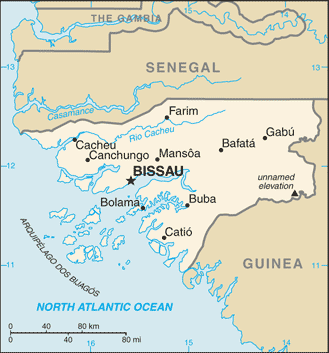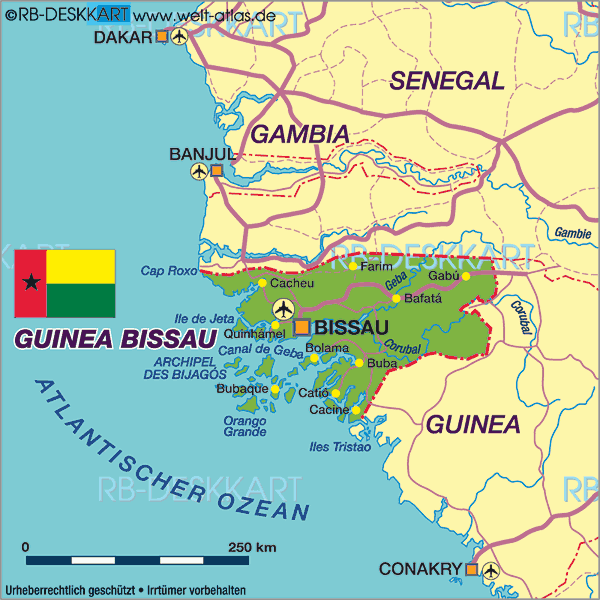Guinea-Bissau Map - Guinea-Bissau
Guinea-Bissau (Listeni/ˈɡɪni bɪˈsaʊ/, gi-nee-bi-sow),
officially the Republic of Guinea-Bissau (Portuguese: República da
Guiné-Bissau, pronounced: [ʁeˈpublikɐ dɐ ɡiˈnɛ biˈsaw]), is a country in West
Africa. It covers 36,125 square kilometres (13,948 sq mi) with an estimated
population of 1,704,000.
Guinea-Bissau Map - Guinea-Bissau Satellite Image - Physical ...
Guinea-Bissau was once part of the kingdom of Gabu, as well as part of the Mali Empire. Parts of this kingdom persisted until the 18th century, while a few others were under some rule by the Portuguese Empire since the 16th century. In the 19th century, it was colonized as Portuguese Guinea. Upon independence, declared in 1973 and recognised in 1974, the name of its capital, Bissau, was added to the country's name to prevent confusion with Guinea (formerly French Guinea). Guinea-Bissau has a history of political instability since independence, and no elected president has successfully served a full five-year term.
Political Map of Guinea Bissau
Only 14% of the population speaks Portuguese, established as the official language in the colonial period. Almost half the population (44%) speaks Crioulo, a Portuguese-based creole language, and the remainder speak a variety of native African languages. The main religions are African traditional religions and Islam; there is a Christian (mostly Roman Catholic) minority. The country's per-capita gross domestic product is one of the lowest in the world.
Guinea-Bissau Atlas: Maps and Online Resources
Guinea-Bissau is a member of the United Nations, African Union, Economic Community of West African States, Organisation of Islamic Cooperation, the Latin Union, Community of Portuguese Language Countries, La Francophonie and the South Atlantic Peace and Cooperation Zone.
Political Map of Guinea Bissau
Guinea-Bissau was once part of the kingdom of Gabu,
part of the Mali Empire; parts of this kingdom persisted until the 18th
century. Other parts of the territory in the current country were considered by
the Portuguese as part of their empire.[5] Portuguese Guinea was known as the
Slave Coast, as it was a major area for the exportation of African slaves by
Europeans to the western hemisphere. Previously slaves had been traded by Arabs
north to the northern part of Africa and into the Middle East.
Early reports of Europeans reaching this area include
those of the Venetian Alvise Cadamosto's voyage of 1455,[6] the 1479–1480
voyage by Flemish-French trader Eustache de la Fosse,[7] and Diogo Cão. In the
1480s this Portuguese explorer reached the Congo River and the lands of
Bakongo, setting up the foundations of modern Angola, some 4200 km down the
African coast from Guinea-Bissau.[8]
Road Map of Guinea Bissau
Although the rivers and coast of this area were among the first places colonized by the Portuguese, who set up trading posts in the 16th century, they did not explore the interior until the 19th century. The local African rulers in Guinea, some of whom prospered greatly from the slave trade, controlled the inland trade and did not allow the Europeans into the interior. They kept them in the fortified coastal settlements where the trading took place.[9] African communities that fought back against slave traders also distrusted European adventurers and would-be settlers. The Portuguese in Guinea were largely restricted to the port of Bissau and Cacheu. A small number of European settlers established isolated farms along Bissau's inland rivers.[9]
Guinea-Bissau Map / Geography of Guinea-Bissau
For a brief period in the 1790s, the British tried to establish a rival foothold on an offshore island, at Bolama.[10] But by the 19th century the Portuguese were sufficiently secure in Bissau to regard the neighbouring coastline as their own special territory, also up north in part of present South Senegal.
Physical Map of Guinea Bissau
An armed rebellion beginning in 1956 by the African Party for the Independence of Guinea and Cape Verde (PAIGC) under the leadership of Amílcar Cabral gradually consolidated its hold on then Portuguese Guinea.[11] Unlike guerrilla movements in other Portuguese colonies, the PAIGC rapidly extended its military control over large portions of the territory, aided by the jungle-like terrain, its easily reached borderlines with neighbouring allies, and large quantities of arms from Cuba, China, the Soviet Union, and left-leaning African countries.[12] Cuba also agreed to supply artillery experts, doctors, and technicians.[13] The PAIGC even managed to acquire a significant anti-aircraft capability in order to defend itself against aerial attack. By 1973, the PAIGC was in control of many parts of Guinea, although the movement suffered a setback in January 1973 when Cabral was assassinated.[14]
Administrative Map of Guinea-Bissau
Independence was unilaterally declared on 24 September
1973. Recognition became universal following the 25 April 1974
socialist-inspired military coup in Portugal, which overthrew Lisbon's Estado
Novo regime.[15]
Guinea Bissau Political Map
Luís Cabral, brother of Amílcar and co-founder of PAIGC, was appointed the first President of Guinea-Bissau. Following independence, the PAIGC killed thousands of local Guinean soldiers who had fought along with the Portuguese Army against guerrillas. Some escaped to settle in Portugal or other African nations.[16] One of the massacres occurred in the town of Bissorã. In 1980 the PAIGC acknowledged in its newspaper Nó Pintcha (dated 29 November 1980) that many Gueinean soldiers had been executed and buried in unmarked collective graves in the woods of Cumerá, Portogole, and Mansabá.
Guinea-Bissau Map / Geography of Guinea-Bissau
The country was controlled by a revolutionary council until 1984. The first multi-party elections were held in 1994. An army uprising in May 1998 led to the Guinea-Bissau Civil War and the president's ousting in June 1999.[17] Elections were held again in 2000, and Kumba Ialá was elected president.[18]
In September 2003, a military coup was conducted. The military arrested Ialá on the charge of being "unable to solve the problems".[19] After being delayed several times, legislative elections were held in March 2004. A mutiny of military factions in October 2004 resulted in the death of the head of the armed forces and caused widespread unrest.
Guinea Bissau Maps - Perry
In June 2005, presidential elections were held for the
first time since the coup that deposed Ialá. Ialá returned as the candidate for
the PRS, claiming to be the legitimate president of the country, but the
election was won by former president João Bernardo Vieira, deposed in the 1999
coup. Vieira beat Malam Bacai Sanhá in a runoff election. Sanhá initially
refused to concede, claiming that tampering and electoral fraud occurred in two
constituencies including the capital, Bissau.[20]
Despite reports of arms entering the country prior to
the election and some "disturbances during campaigning," including
attacks on government offices by unidentified gunmen, foreign election monitors
described the 2005 election overall as "calm and organized".[21]
Guinea Bissau Political Map | Political Map of Guinea Bissau ...
Three years later, PAIGC won a strong parliamentary majority, with 67 of 100 seats, in the parliamentary election held in November 2008.[22] In November 2008, President Vieira's official residence was attacked by members of the armed forces, killing a guard but leaving the president unharmed.[23]
Guinea-Bissau | Operation World
On 2 March 2009, however, Vieira was assassinated by what preliminary reports indicated to be a group of soldiers avenging the death of the head of joint chiefs of staff, General Batista Tagme Na Wai. Tagme died in an explosion on Sunday, 1 March 2009, target of an assassination. Military leaders in the country pledged to respect the constitutional order of succession. National Assembly Speaker Raimundo Pereira was appointed as an interim president until a nationwide election on 28 June 2009.[24] It was won by Malam Bacai Sanhá.
Map of Guinea-Bissau
On the evening of 12 April 2012, members of the country's military staged a coup d'état and arrested the interim president and a leading presidential candidate.[25] Former vice chief of staff, General Mamadu Ture Kuruma, assumed control of the country in the transitional period and started negotiations with opposition parties.[26][27]
Guinea Bissau Cities Map, Major Cities in Guinea Bissau
Map of Guinea Bissau - Map in the Atlas of the World - World Guinea-Bissau is a republic. In the past, the government had been highly centralized. Multi-party governance was not established until mid-1991. The president is the head of state and the prime minister is the head of government. Since 1974, no president has successfully served a full five-year term.[28]
At the legislative level, a unicameral Assembleia Nacional Popular (National People's Assembly) is made up of 100 members. They are popularly elected from multi-member constituencies to serve a four-year term. The judicial system is headed by a Tribunal Supremo da Justiça (Supreme Court), made up of nine justices appointed by the president; they serve at the pleasure of the president.[29]
Guinea-Bissau Guide
João Bernardo "Nino" Vieira was elected in
2005 as President of Guinea-Bissau as an independent, being declared winner of
the second round by the CNE (Comité Nacional de Eleições). Vieira returned to
power in 2005 six years after being ousted from office during a civil war.
Previously, he held power for 19 years after taking power in 1980 in a
bloodless coup. In that action, he toppled the government of Luís Cabral.
Guinea-Bissau Map - Guinea-Bissau
He was killed on 2 March 2009, possibly by soldiers in retaliation for the assassination of General Batista Tagme Na Waie, the head of the joint chiefs of staff, killed in an explosion.[30] Vieira's death did not trigger widespread violence, but there were signs of turmoil in the country, according to the advocacy group Swisspeace.[31] Malam Bacai Sanhá was elected after a transition. In the 2009 election to replace the assassinated Vieira, Sanhá was the presidential candidate of the PAIGC while Kumba Ialá was the presidential candidate of the PRS.
Guinea-Bissau - Wikipedia, the free encyclopedia
In 2012, President Rachide Sambu-balde Malam Bacai Sanhá died. He belonged to PAIGC (African Party for the Independence of Guinea and Cape Verde), one of the two major political parties in Guinea-Bissau, along with the PRS (Party for Social Renewal). There are more than 20 minor parties.[32]



Hiç yorum yok:
Yorum Gönder